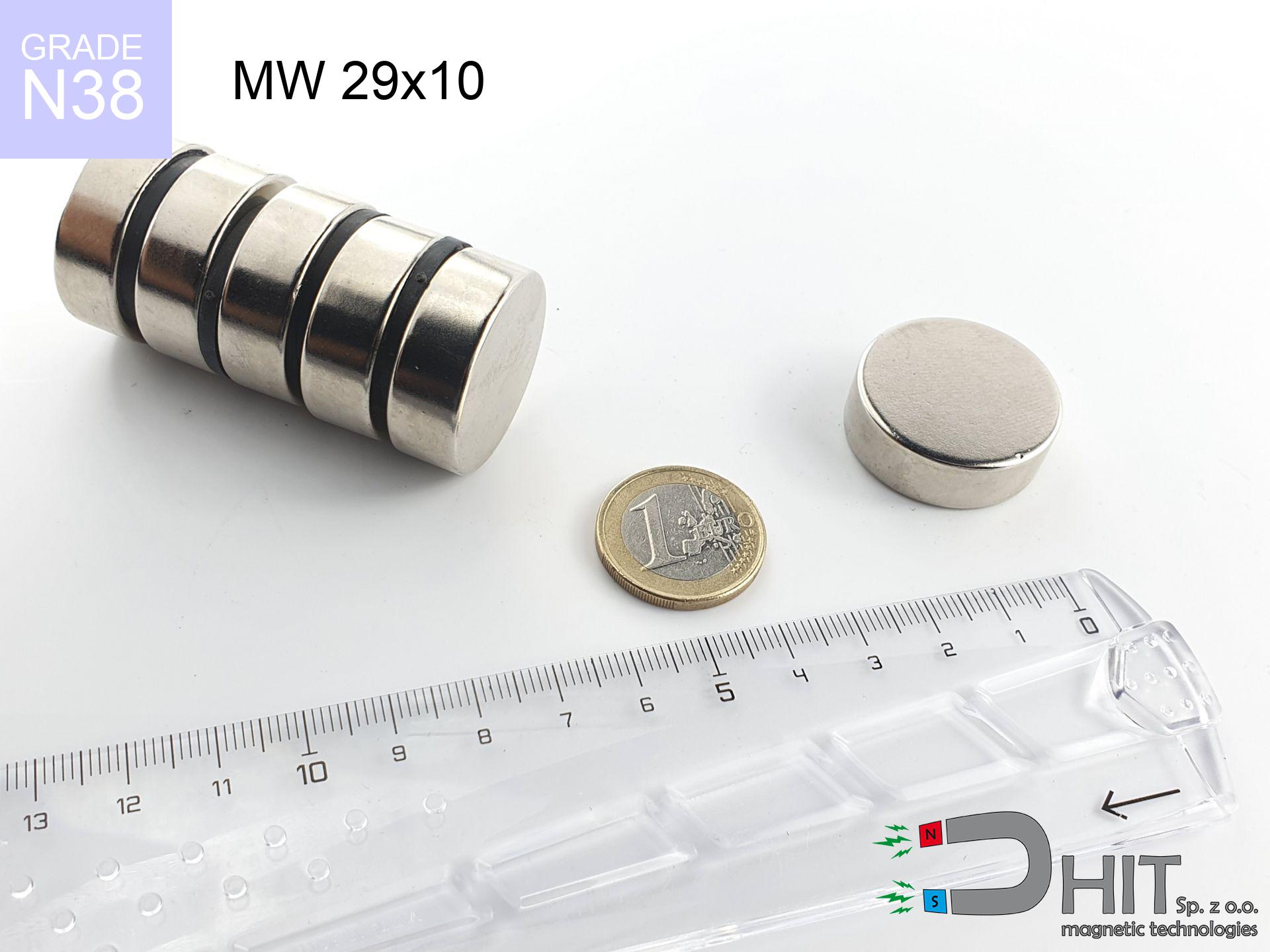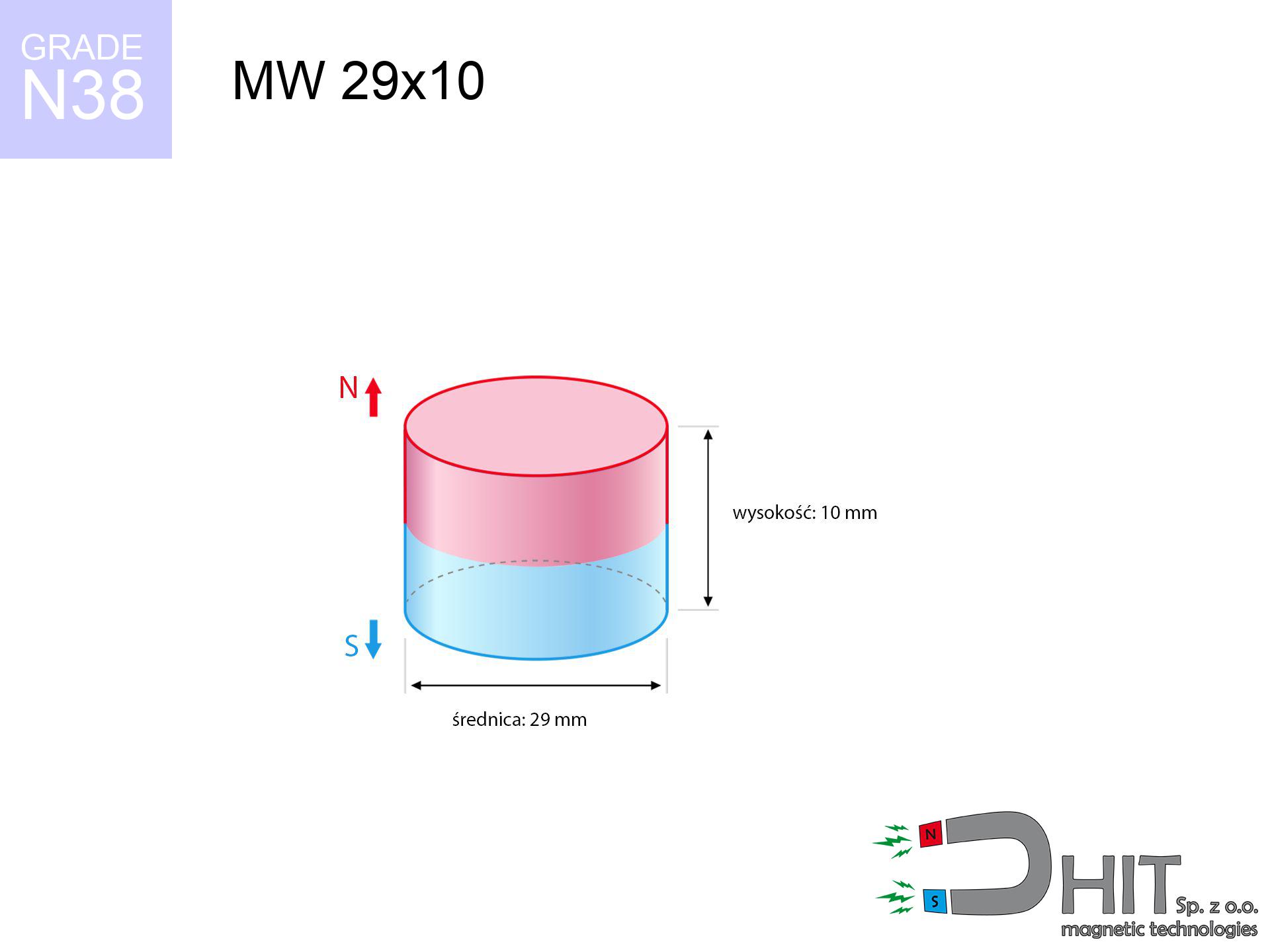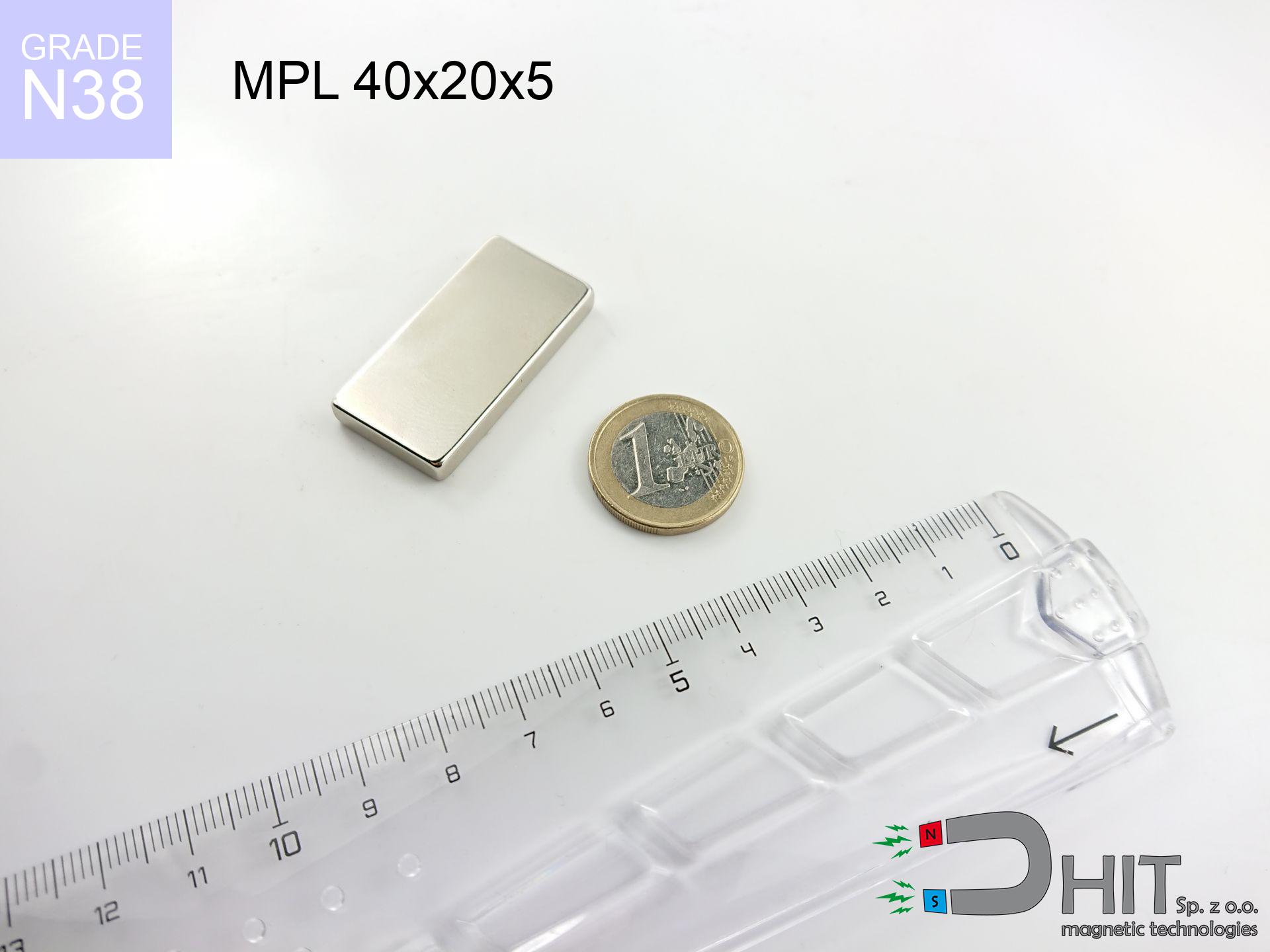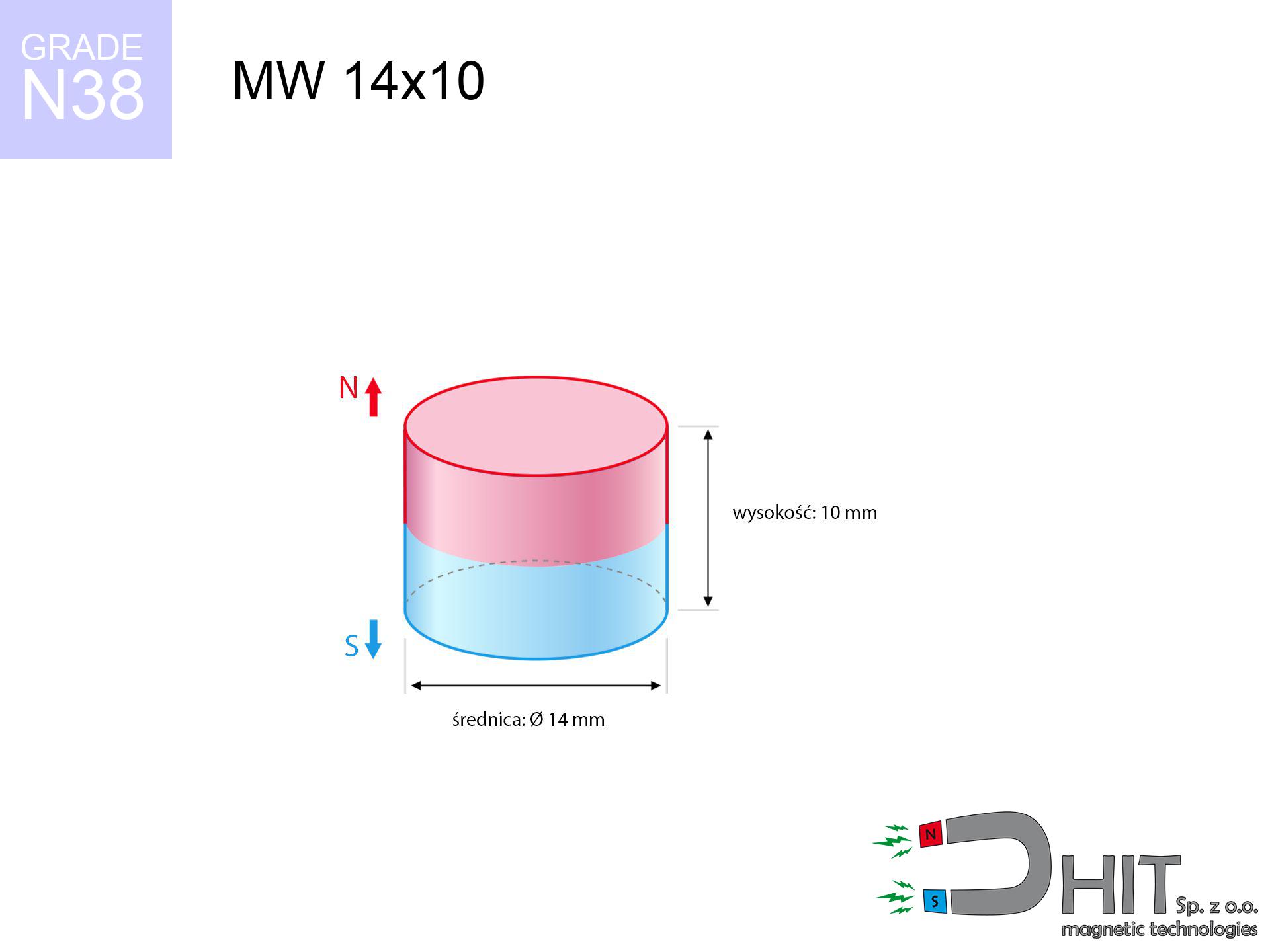MW 29x10 / N38 - cylindrical magnet
cylindrical magnet
Catalog no 010053
GTIN/EAN: 5906301810520
Diameter Ø
29 mm [±0,1 mm]
Height
10 mm [±0,1 mm]
Weight
49.54 g
Magnetization Direction
↑ axial
Load capacity
20.82 kg / 204.22 N
Magnetic Induction
351.88 mT / 3519 Gs
Coating
[NiCuNi] Nickel
17.34 ZŁ with VAT / pcs + price for transport
14.10 ZŁ net + 23% VAT / pcs
bulk discounts:
Need more?Want to talk magnets?
Call us now
+48 888 99 98 98
alternatively get in touch using
our online form
the contact page.
Strength along with shape of a magnet can be verified with our
power calculator.
Order by 14:00 and we’ll ship today!
MW 29x10 / N38 - cylindrical magnet
Specification / characteristics MW 29x10 / N38 - cylindrical magnet
| properties | values |
|---|---|
| Cat. no. | 010053 |
| GTIN/EAN | 5906301810520 |
| Production/Distribution | Dhit sp. z o.o. |
| Country of origin | Poland / China / Germany |
| Customs code | 85059029 |
| Diameter Ø | 29 mm [±0,1 mm] |
| Height | 10 mm [±0,1 mm] |
| Weight | 49.54 g |
| Magnetization Direction | ↑ axial |
| Load capacity ~ ? | 20.82 kg / 204.22 N |
| Magnetic Induction ~ ? | 351.88 mT / 3519 Gs |
| Coating | [NiCuNi] Nickel |
| Manufacturing Tolerance | ±0.1 mm |
Magnetic properties of material N38
| properties | values | units |
|---|---|---|
| remenance Br [min. - max.] ? | 12.2-12.6 | kGs |
| remenance Br [min. - max.] ? | 1220-1260 | mT |
| coercivity bHc ? | 10.8-11.5 | kOe |
| coercivity bHc ? | 860-915 | kA/m |
| actual internal force iHc | ≥ 12 | kOe |
| actual internal force iHc | ≥ 955 | kA/m |
| energy density [min. - max.] ? | 36-38 | BH max MGOe |
| energy density [min. - max.] ? | 287-303 | BH max KJ/m |
| max. temperature ? | ≤ 80 | °C |
Physical properties of sintered neodymium magnets Nd2Fe14B at 20°C
| properties | values | units |
|---|---|---|
| Vickers hardness | ≥550 | Hv |
| Density | ≥7.4 | g/cm3 |
| Curie Temperature TC | 312 - 380 | °C |
| Curie Temperature TF | 593 - 716 | °F |
| Specific resistance | 150 | μΩ⋅cm |
| Bending strength | 250 | MPa |
| Compressive strength | 1000~1100 | MPa |
| Thermal expansion parallel (∥) to orientation (M) | (3-4) x 10-6 | °C-1 |
| Thermal expansion perpendicular (⊥) to orientation (M) | -(1-3) x 10-6 | °C-1 |
| Young's modulus | 1.7 x 104 | kg/mm² |
Technical simulation of the product - report
The following information represent the direct effect of a mathematical simulation. Values rely on models for the material Nd2Fe14B. Operational performance might slightly differ from theoretical values. Please consider these calculations as a supplementary guide when designing systems.
MW 29x10 / N38
| Distance (mm) | Induction (Gauss) / mT | Pull Force (kg) | Risk Status |
|---|---|---|---|
| 0 mm |
3518 Gs
351.8 mT
|
20.82 kg / 20820.0 g
204.2 N
|
crushing |
| 1 mm |
3321 Gs
332.1 mT
|
18.55 kg / 18548.8 g
182.0 N
|
crushing |
| 2 mm |
3106 Gs
310.6 mT
|
16.23 kg / 16226.1 g
159.2 N
|
crushing |
| 3 mm |
2883 Gs
288.3 mT
|
13.98 kg / 13978.2 g
137.1 N
|
crushing |
| 5 mm |
2437 Gs
243.7 mT
|
9.99 kg / 9987.1 g
98.0 N
|
warning |
| 10 mm |
1500 Gs
150.0 mT
|
3.78 kg / 3783.1 g
37.1 N
|
warning |
| 15 mm |
905 Gs
90.5 mT
|
1.38 kg / 1379.2 g
13.5 N
|
low risk |
| 20 mm |
563 Gs
56.3 mT
|
0.53 kg / 532.4 g
5.2 N
|
low risk |
| 30 mm |
247 Gs
24.7 mT
|
0.10 kg / 102.4 g
1.0 N
|
low risk |
| 50 mm |
72 Gs
7.2 mT
|
0.01 kg / 8.7 g
0.1 N
|
low risk |
MW 29x10 / N38
| Distance (mm) | Friction coefficient | Pull Force (kg) |
|---|---|---|
| 0 mm | Stal (~0.2) |
4.16 kg / 4164.0 g
40.8 N
|
| 1 mm | Stal (~0.2) |
3.71 kg / 3710.0 g
36.4 N
|
| 2 mm | Stal (~0.2) |
3.25 kg / 3246.0 g
31.8 N
|
| 3 mm | Stal (~0.2) |
2.80 kg / 2796.0 g
27.4 N
|
| 5 mm | Stal (~0.2) |
2.00 kg / 1998.0 g
19.6 N
|
| 10 mm | Stal (~0.2) |
0.76 kg / 756.0 g
7.4 N
|
| 15 mm | Stal (~0.2) |
0.28 kg / 276.0 g
2.7 N
|
| 20 mm | Stal (~0.2) |
0.11 kg / 106.0 g
1.0 N
|
| 30 mm | Stal (~0.2) |
0.02 kg / 20.0 g
0.2 N
|
| 50 mm | Stal (~0.2) |
0.00 kg / 2.0 g
0.0 N
|
MW 29x10 / N38
| Surface type | Friction coefficient / % Mocy | Max load (kg) |
|---|---|---|
| Raw steel |
µ = 0.3
30% Nominalnej Siły
|
6.25 kg / 6246.0 g
61.3 N
|
| Painted steel (standard) |
µ = 0.2
20% Nominalnej Siły
|
4.16 kg / 4164.0 g
40.8 N
|
| Oily/slippery steel |
µ = 0.1
10% Nominalnej Siły
|
2.08 kg / 2082.0 g
20.4 N
|
| Magnet with anti-slip rubber |
µ = 0.5
50% Nominalnej Siły
|
10.41 kg / 10410.0 g
102.1 N
|
MW 29x10 / N38
| Steel thickness (mm) | % power | Real pull force (kg) |
|---|---|---|
| 0.5 mm |
|
1.04 kg / 1041.0 g
10.2 N
|
| 1 mm |
|
2.60 kg / 2602.5 g
25.5 N
|
| 2 mm |
|
5.21 kg / 5205.0 g
51.1 N
|
| 5 mm |
|
13.01 kg / 13012.5 g
127.7 N
|
| 10 mm |
|
20.82 kg / 20820.0 g
204.2 N
|
MW 29x10 / N38
| Ambient temp. (°C) | Power loss | Remaining pull | Status |
|---|---|---|---|
| 20 °C | 0.0% |
20.82 kg / 20820.0 g
204.2 N
|
OK |
| 40 °C | -2.2% |
20.36 kg / 20362.0 g
199.8 N
|
OK |
| 60 °C | -4.4% |
19.90 kg / 19903.9 g
195.3 N
|
|
| 80 °C | -6.6% |
19.45 kg / 19445.9 g
190.8 N
|
|
| 100 °C | -28.8% |
14.82 kg / 14823.8 g
145.4 N
|
MW 29x10 / N38
| Gap (mm) | Attraction (kg) (N-S) | Repulsion (kg) (N-N) |
|---|---|---|
| 0 mm |
50.40 kg / 50399 g
494.4 N
5 016 Gs
|
N/A |
| 1 mm |
47.70 kg / 47704 g
468.0 N
6 845 Gs
|
42.93 kg / 42934 g
421.2 N
~0 Gs
|
| 2 mm |
44.90 kg / 44901 g
440.5 N
6 641 Gs
|
40.41 kg / 40411 g
396.4 N
~0 Gs
|
| 3 mm |
42.08 kg / 42082 g
412.8 N
6 429 Gs
|
37.87 kg / 37874 g
371.5 N
~0 Gs
|
| 5 mm |
36.52 kg / 36522 g
358.3 N
5 990 Gs
|
32.87 kg / 32870 g
322.5 N
~0 Gs
|
| 10 mm |
24.18 kg / 24176 g
237.2 N
4 873 Gs
|
21.76 kg / 21758 g
213.4 N
~0 Gs
|
| 20 mm |
9.16 kg / 9158 g
89.8 N
2 999 Gs
|
8.24 kg / 8242 g
80.9 N
~0 Gs
|
| 50 mm |
0.54 kg / 542 g
5.3 N
729 Gs
|
0.49 kg / 487 g
4.8 N
~0 Gs
|
MW 29x10 / N38
| Object / Device | Limit (Gauss) / mT | Safe distance |
|---|---|---|
| Pacemaker | 5 Gs (0.5 mT) | 13.5 cm |
| Hearing aid | 10 Gs (1.0 mT) | 10.5 cm |
| Mechanical watch | 20 Gs (2.0 mT) | 8.5 cm |
| Mobile device | 40 Gs (4.0 mT) | 6.5 cm |
| Car key | 50 Gs (5.0 mT) | 6.0 cm |
| Payment card | 400 Gs (40.0 mT) | 2.5 cm |
| HDD hard drive | 600 Gs (60.0 mT) | 2.0 cm |
MW 29x10 / N38
| Start from (mm) | Speed (km/h) | Energy (J) | Predicted outcome |
|---|---|---|---|
| 10 mm |
22.90 km/h
(6.36 m/s)
|
1.00 J | |
| 30 mm |
35.92 km/h
(9.98 m/s)
|
2.47 J | |
| 50 mm |
46.24 km/h
(12.85 m/s)
|
4.09 J | |
| 100 mm |
65.38 km/h
(18.16 m/s)
|
8.17 J |
MW 29x10 / N38
| Technical parameter | Value / Description |
|---|---|
| Coating type | [NiCuNi] Nickel |
| Layer structure | Nickel - Copper - Nickel |
| Layer thickness | 10-20 µm |
| Salt spray test (SST) ? | 24 h |
| Recommended environment | Indoors only (dry) |
MW 29x10 / N38
| Parameter | Value | SI Unit / Description |
|---|---|---|
| Magnetic Flux | 24 471 Mx | 244.7 µWb |
| Pc Coefficient | 0.45 | Low (Flat) |
MW 29x10 / N38
| Environment | Effective steel pull | Effect |
|---|---|---|
| Air (land) | 20.82 kg | Standard |
| Water (riverbed) |
23.84 kg
(+3.02 kg Buoyancy gain)
|
+14.5% |
1. Sliding resistance
*Note: On a vertical wall, the magnet holds merely a fraction of its perpendicular strength.
2. Steel saturation
*Thin steel (e.g. 0.5mm PC case) severely limits the holding force.
3. Thermal stability
*For N38 material, the max working temp is 80°C.
4. Demagnetization curve and operating point (B-H)
chart generated for the permeance coefficient Pc (Permeance Coefficient) = 0.45
The chart above illustrates the magnetic characteristics of the material within the second quadrant of the hysteresis loop. The solid red line represents the demagnetization curve (material potential), while the dashed blue line is the load line based on the magnet's geometry. The Pc (Permeance Coefficient), also known as the load line slope, is a dimensionless value that describes the relationship between the magnet's shape and its magnetic stability. The intersection of these two lines (the black dot) is the operating point — it determines the actual magnetic flux density generated by the magnet in this specific configuration. A higher Pc value means the magnet is more 'slender' (tall relative to its area), resulting in a higher operating point and better resistance to irreversible demagnetization caused by external fields or temperature. A value of 0.42 is relatively low (typical for flat magnets), meaning the operating point is closer to the 'knee' of the curve — caution is advised when operating at temperatures near the maximum limit to avoid strength loss.
Elemental analysis
| iron (Fe) | 64% – 68% |
| neodymium (Nd) | 29% – 32% |
| boron (B) | 1.1% – 1.2% |
| dysprosium (Dy) | 0.5% – 2.0% |
| coating (Ni-Cu-Ni) | < 0.05% |
Sustainability
| recyclability (EoL) | 100% |
| recycled raw materials | ~10% (pre-cons) |
| carbon footprint | low / zredukowany |
| waste code (EWC) | 16 02 16 |
Other offers
Advantages as well as disadvantages of Nd2Fe14B magnets.
Pros
- They virtually do not lose power, because even after ten years the decline in efficiency is only ~1% (in laboratory conditions),
- They feature excellent resistance to weakening of magnetic properties as a result of opposing magnetic fields,
- Thanks to the metallic finish, the surface of Ni-Cu-Ni, gold-plated, or silver gives an modern appearance,
- Magnetic induction on the surface of the magnet remains exceptional,
- Neodymium magnets are characterized by very high magnetic induction on the magnet surface and can function (depending on the shape) even at a temperature of 230°C or more...
- Thanks to flexibility in forming and the capacity to adapt to client solutions,
- Key role in advanced technology sectors – they are utilized in hard drives, electric drive systems, advanced medical instruments, and modern systems.
- Thanks to efficiency per cm³, small magnets offer high operating force, in miniature format,
Limitations
- At strong impacts they can crack, therefore we advise placing them in special holders. A metal housing provides additional protection against damage, as well as increases the magnet's durability.
- Neodymium magnets decrease their power under the influence of heating. As soon as 80°C is exceeded, many of them start losing their power. Therefore, we recommend our special magnets marked [AH], which maintain durability even at temperatures up to 230°C
- Due to the susceptibility of magnets to corrosion in a humid environment, we advise using waterproof magnets made of rubber, plastic or other material immune to moisture, when using outdoors
- Limited possibility of making threads in the magnet and complex forms - preferred is a housing - magnet mounting.
- Possible danger related to microscopic parts of magnets are risky, when accidentally swallowed, which is particularly important in the context of child safety. Furthermore, small elements of these devices are able to disrupt the diagnostic process medical after entering the body.
- With large orders the cost of neodymium magnets is a challenge,
Pull force analysis
Maximum lifting force for a neodymium magnet – what contributes to it?
- with the application of a yoke made of low-carbon steel, ensuring maximum field concentration
- with a thickness of at least 10 mm
- with an polished touching surface
- under conditions of ideal adhesion (surface-to-surface)
- during detachment in a direction perpendicular to the plane
- at ambient temperature room level
Lifting capacity in real conditions – factors
- Distance (betwixt the magnet and the metal), because even a tiny distance (e.g. 0.5 mm) leads to a reduction in force by up to 50% (this also applies to paint, rust or dirt).
- Loading method – declared lifting capacity refers to detachment vertically. When applying parallel force, the magnet holds much less (typically approx. 20-30% of maximum force).
- Wall thickness – the thinner the sheet, the weaker the hold. Part of the magnetic field passes through the material instead of converting into lifting capacity.
- Plate material – mild steel gives the best results. Alloy admixtures lower magnetic permeability and holding force.
- Base smoothness – the smoother and more polished the plate, the larger the contact zone and stronger the hold. Roughness acts like micro-gaps.
- Operating temperature – neodymium magnets have a negative temperature coefficient. When it is hot they lose power, and at low temperatures they can be stronger (up to a certain limit).
Lifting capacity was determined using a smooth steel plate of optimal thickness (min. 20 mm), under vertically applied force, in contrast under parallel forces the lifting capacity is smaller. Additionally, even a slight gap between the magnet and the plate decreases the holding force.
Mechanical processing
Fire warning: Rare earth powder is highly flammable. Do not process magnets without safety gear as this risks ignition.
Avoid contact if allergic
Warning for allergy sufferers: The nickel-copper-nickel coating consists of nickel. If skin irritation happens, cease working with magnets and use protective gear.
Impact on smartphones
Note: rare earth magnets generate a field that disrupts sensitive sensors. Maintain a safe distance from your phone, tablet, and navigation systems.
Serious injuries
Protect your hands. Two large magnets will snap together instantly with a force of several hundred kilograms, crushing anything in their path. Be careful!
Heat warning
Regular neodymium magnets (N-type) undergo demagnetization when the temperature goes above 80°C. This process is irreversible.
ICD Warning
Individuals with a heart stimulator should keep an safe separation from magnets. The magnetic field can interfere with the functioning of the life-saving device.
Magnetic media
Very strong magnetic fields can corrupt files on credit cards, HDDs, and storage devices. Keep a distance of min. 10 cm.
Choking Hazard
Neodymium magnets are not intended for children. Swallowing a few magnets may result in them pinching intestinal walls, which constitutes a critical condition and necessitates immediate surgery.
Immense force
Use magnets consciously. Their immense force can shock even experienced users. Be vigilant and do not underestimate their force.
Eye protection
Watch out for shards. Magnets can explode upon uncontrolled impact, launching sharp fragments into the air. We recommend safety glasses.







![SM 25x200 [2xM8] / N42 - magnetic separator SM 25x200 [2xM8] / N42 - magnetic separator](https://cdn3.dhit.pl/graphics/products/sm-25x200-2xm8-dos.jpg)

